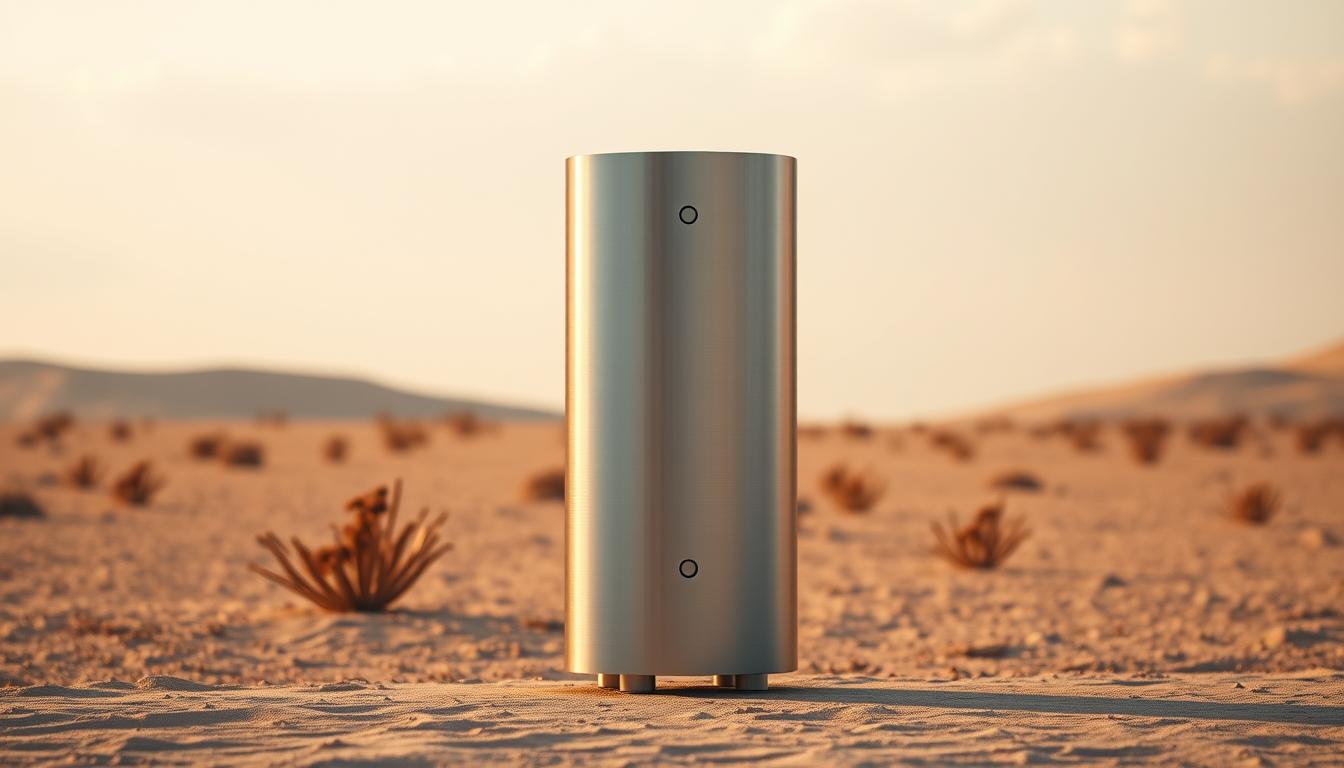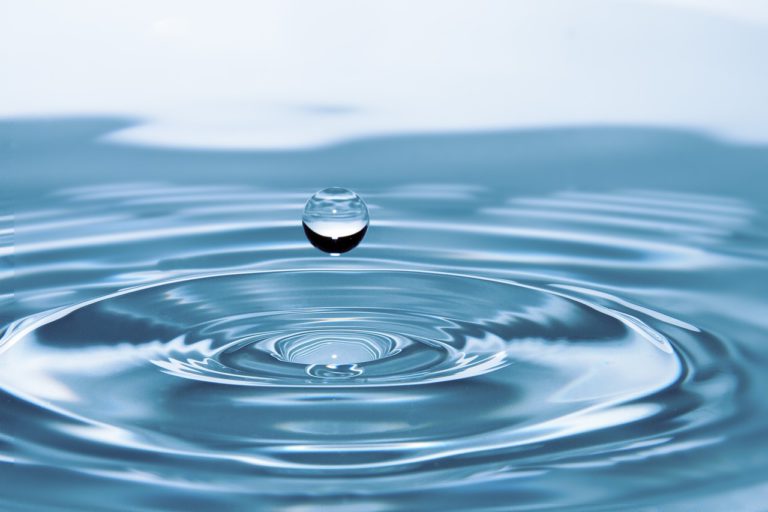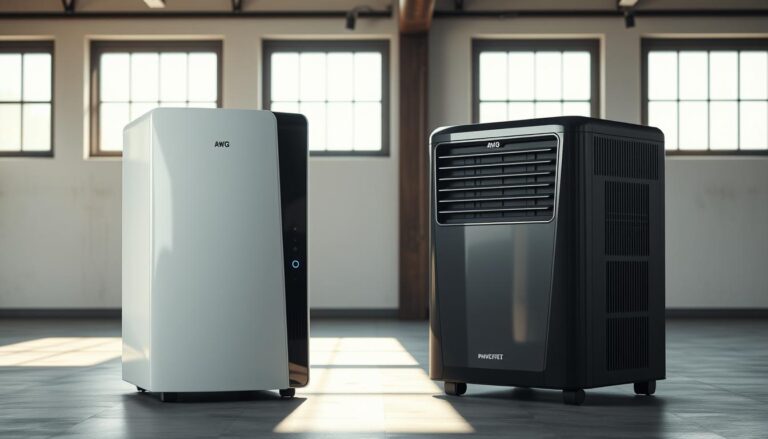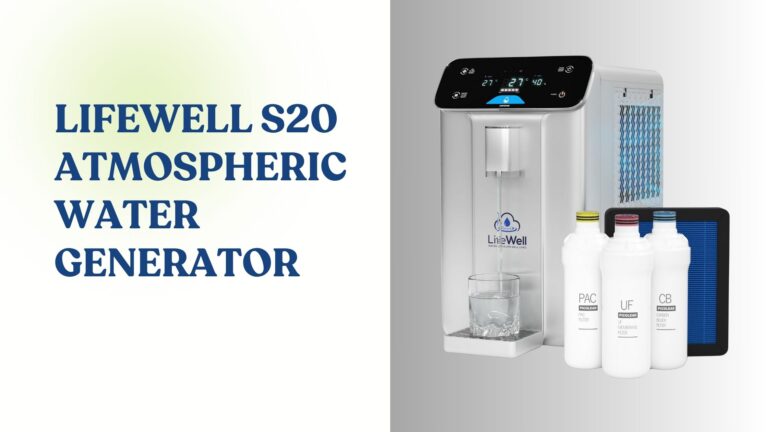Atmospheric Water Generators: Innovative Solutions for Dry Climates
Can we really harvest drinking water from the air, even in the driest of climates? The answer lies in a revolutionary technology that’s changing the way we think about water production.
The production of drinking water from humidity in the air is one of the most innovative solutions available today, used to tackle the growing problem of depleting levels of drinking water in the world. Atmospheric water generators offer a promising solution, particularly in dry climates where traditional water sources are scarce.
Key Takeaways
- Innovative technology for harvesting water from air
- Effective solution for dry climates with scarce water resources
- Addresses the growing issue of global water scarcity
- Provides a reliable source of clean drinking water
- Revolutionizes traditional water production methods
Understanding the Water Crisis in Dry Climates
In dry climates, the water crisis is not just an environmental issue, but a human one, affecting communities and ecosystems alike. The scarcity of water in these regions is a pressing concern that demands immediate attention and innovative solutions.
Global Water Scarcity Statistics
Nearly 90 countries will face severe water shortages by 2050, according to the UN University’s Canada-based Institute for Water, Environment and Health. This stark statistic underscores the global nature of the water crisis, with dry climates being among the most vulnerable.
Unique Challenges of Arid and Semi-Arid Regions
Arid and semi-arid regions face unique challenges, including limited rainfall, high evaporation rates, and often, inadequate infrastructure for water management. These challenges are compounded by factors such as population growth and climate change, which further strain the available water resources.
Traditional Water Solutions and Their Limitations
Traditional water solutions, such as wells and reservoirs, have limitations in dry climates. They often rely on rainfall or existing water sources, which may be scarce or unreliable. This highlights the need for alternative water sources, such as Atmospheric Water Generators (AWGs), particularly those designed for low humidity conditions.
The development and deployment of AWGs in low humidity conditions represent a critical step towards addressing the water crisis in dry climates. By harnessing water from the air, even in the driest of environments, AWGs offer a promising solution to the challenges faced by these regions.
What Are Atmospheric Water Generators?
Atmospheric Water Generators (AWGs) are innovative devices that harvest water from the air, providing a sustainable solution for water scarcity. These systems are designed to extract water from atmospheric humidity, making them particularly valuable in dry climates where traditional water sources may be limited.
Definition and Basic Principles
AWGs operate on the principle of condensing water vapor from the air into liquid water. The best atmospheric water generator for low humidity conditions uses advanced technologies to cool the air or absorb moisture, thereby condensing water vapor into liquid. This process involves either cooling the air to its dew point or using desiccants to absorb moisture, which is then heated to release the water vapor, condensed, and collected.
Historical Development of AWG Technology
The concept of harvesting water from air is not new, but modern AWG technology has evolved significantly. Early versions were large, energy-intensive, and not very efficient. However, advancements in materials science and engineering have led to more efficient AWG in low humidity areas. Today, AWGs are being developed with capacities ranging from home-based units producing up to 20 liters per day to commercial and industrial systems generating up to 10,000 liters or more per day.
Components of a Modern AWG System
A modern AWG system typically consists of several key components, including air intake filters, a heat exchange system, a condenser coil, and a control unit. The efficient AWG in low humidity areas incorporates advanced materials and designs, such as improved desiccants or more efficient condensers, to enhance water production. For more detailed information on AWGs, you can visit the Wikipedia page on Atmospheric Water Generators.
The Science Behind Atmospheric Water Generator Low Humidity Performance
The science behind AWGs’ efficiency in low humidity climates is multifaceted, involving intricate processes that condense and extract water from air. Understanding this technology requires delving into the physics of water vapor in arid conditions, the challenges of extraction efficiency, and the minimum humidity thresholds for operation.
Water Vapor Physics in Arid Conditions
In arid environments, the air is typically dry, with low relative humidity. However, even in these conditions, there is still water vapor present in the air. AWGs exploit this by using advanced technologies to condense and extract this water vapor. The process involves cooling the air to its dew point, causing the water vapor to condense into liquid water. This technology is crucial for regions where traditional water sources are scarce.
Extraction Efficiency Challenges
One of the primary challenges facing AWGs in low humidity environments is extraction efficiency. When the air is very dry, more energy is required to extract the same amount of water compared to more humid conditions. This challenge necessitates the development of more efficient systems that can operate effectively at low humidity levels. Advanced materials and innovative designs are being explored to address this issue.
Minimum Humidity Thresholds for Operation
While AWGs can operate in relatively low humidity conditions, there is a minimum threshold below which they cannot efficiently extract water. Some AWG systems can produce significant water volumes in desert conditions with relative humidity as low as 15% to 20%. Understanding these thresholds is crucial for determining the suitability of AWGs for specific locations.
Technical Limitations
The technical limitations of AWGs in low humidity environments include the energy required for operation and the materials used in their construction. Efficient energy recovery systems and advanced materials are key to overcoming these limitations. For instance, using desiccants that can effectively capture moisture from the air even at low humidity levels can significantly enhance performance.
Practical Considerations
Practically, the deployment of AWGs in arid regions requires careful consideration of several factors, including the local climate, energy availability, and maintenance needs. Ensuring that these systems are designed with the local environment in mind is crucial for their success. This includes selecting materials that can withstand the harsh conditions often found in arid environments.
Types of Atmospheric Water Generators for Low Humidity Conditions
The quest for clean water in arid regions has led to the development of diverse AWG technologies. These innovative systems are designed to extract water from the air, even in conditions with very low humidity.
Cooling Condensation Systems
Cooling condensation systems are one of the most common types of AWGs. They work by cooling the air to its dew point, causing the water vapor to condense into liquid water. These systems are effective in a wide range of humidity conditions, including low humidity environments.
Key advantages:
- Proven technology with a long history of use
- Can be powered by various energy sources, including renewable energy
- Effective in a wide range of humidity conditions
Desiccant-Based Systems
Desiccant-based AWGs use a desiccant material to absorb moisture from the air. The absorbed water is then extracted through a heating process, providing clean drinking water. These systems are particularly effective in low humidity conditions.
Key benefits:
- High efficiency in low humidity environments
- Can be designed for off-grid operation
- Low maintenance requirements
Hybrid Technologies
Hybrid AWGs combine different technologies to optimize water production in various environmental conditions. Two notable examples are combined cooling and desiccant approaches, as well as solar-powered hybrid systems.
Combined Cooling and Desiccant Approaches
These systems integrate the benefits of both cooling condensation and desiccant-based technologies. By combining these approaches, AWGs can achieve higher water production rates and operate efficiently across a broader range of humidity levels.
Solar-Powered Hybrid Systems
Solar-powered hybrid AWGs utilize solar energy to power the water generation process. This makes them ideal for off-grid applications and reduces their carbon footprint. These systems often combine photovoltaic panels with advanced desiccant materials or cooling condensation technology.
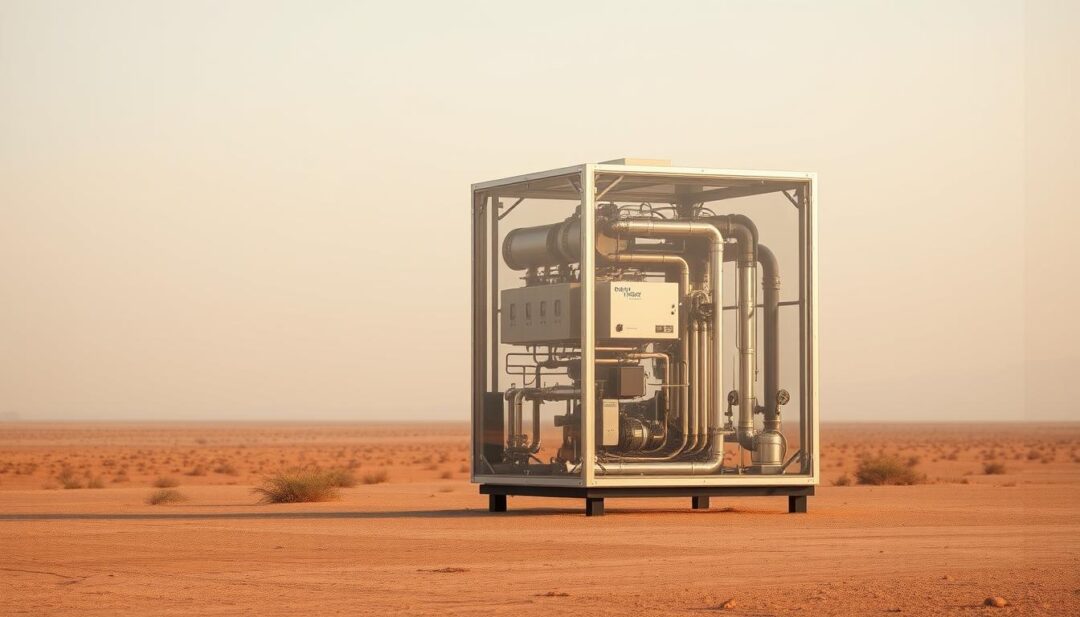
The development of these advanced AWG technologies is crucial for addressing water scarcity in dry climates. By understanding the different types of AWGs available, individuals and organizations can make informed decisions about which systems to implement in their specific contexts.
Key Factors Affecting AWG Performance in Dry Climates
The performance of Atmospheric Water Generators (AWGs) in dry climates is influenced by several critical factors. Understanding these elements is crucial for optimizing AWG operation and ensuring reliable water production in arid regions.
Humidity Levels and Their Impact
Humidity plays a significant role in AWG performance. Water production rates are largely controlled by air humidity, with ideal operating conditions typically between 40% and 100% relative humidity. In dry climates, where humidity levels are often below 40%, AWGs face significant challenges in extracting sufficient water from the air. Research has shown that even in arid conditions, there is still some water vapor present, which can be harvested with the right technology as discussed in recent studies.
Temperature Considerations
Temperature is another crucial factor affecting AWG performance. While AWGs can operate within a range of temperatures, optimal performance is typically achieved between 21°C and 32°C. Extreme temperatures, either high or low, can impact the efficiency of the AWG system. In dry climates, where temperatures can soar during the day, it’s essential to consider temperature fluctuations when designing and operating AWG systems.
Energy Efficiency Challenges
Energy efficiency is a significant challenge for AWGs, particularly in dry climates where more energy is required to extract water from the air. Efficient energy use is crucial for sustainable operation, and advancements in technology are continually improving the energy efficiency of AWG systems.
Maintenance Requirements in Dusty Environments
Maintenance is a critical aspect of AWG operation in dry climates, where dusty conditions can lead to increased wear and tear on the system. Regular maintenance is necessary to ensure optimal performance and longevity of the AWG. This includes cleaning filters, checking for dust accumulation, and ensuring that all components are functioning correctly.
Innovative Technologies Enhancing AWG Efficiency
The development of innovative water generators for low humidity conditions is revolutionizing the way we access clean water. Researchers and manufacturers are continually improving Atmospheric Water Generator (AWG) technology to make it more efficient and effective in dry climates.
Advanced Desiccant Materials
One of the key innovations in AWG technology is the development of advanced desiccant materials. These materials have a higher capacity to absorb and retain moisture from the air, even in low humidity conditions. This improvement allows AWGs to operate more efficiently and produce more water.
Energy Recovery Systems
Energy recovery systems are another crucial technology enhancing AWG efficiency. These systems capture and reuse energy that would otherwise be wasted, reducing the overall energy consumption of the AWG. This is particularly important in off-grid applications where energy efficiency is critical.
Smart Controls and Optimization Algorithms
The integration of smart controls and optimization algorithms has significantly improved AWG performance. These systems monitor environmental conditions and adjust the AWG’s operation in real-time to maximize water production while minimizing energy consumption.
Renewable Energy Integration
The use of renewable energy sources is becoming increasingly important for AWG systems, especially in remote or off-grid locations. Two primary renewable energy sources being integrated with AWGs are solar and wind power.
Solar Power Solutions
Solar power is particularly well-suited for AWGs as it provides a reliable source of energy during the day when water demand is typically highest. Solar-powered AWGs can operate independently of the grid, making them ideal for remote communities.
Wind Energy Applications
Wind energy is another viable option for powering AWGs, especially in areas with consistent wind patterns. Wind turbines can provide a steady supply of electricity, complementing the AWG’s operation.
| Innovative Technology | Benefits | Impact on AWG Efficiency |
|---|---|---|
| Advanced Desiccant Materials | Higher moisture absorption capacity | Increased water production in low humidity conditions |
| Energy Recovery Systems | Reduced energy consumption | Lower operating costs and improved sustainability |
| Smart Controls and Optimization Algorithms | Real-time monitoring and adjustments | Maximized water production and energy efficiency |
| Renewable Energy Integration | Sustainable power sources | Reduced reliance on grid power and lower carbon footprint |
Real-World Applications and Case Studies
The versatility of Atmospheric Water Generators is evident in their diverse applications worldwide. These innovative devices are not only providing clean water in arid regions but are also being adapted for various uses across different sectors.
Residential AWG Solutions in the American Southwest
In the dry climates of the American Southwest, companies like Source and Watergen are providing residential AWG solutions. These systems are designed to meet the water needs of households, offering a reliable and sustainable source of clean water.
Commercial and Industrial Implementations
Beyond residential use, AWGs are being implemented in commercial and industrial settings. For instance, they are used in offices, hotels, and manufacturing facilities to supplement traditional water supplies, reducing reliance on municipal water and enhancing water security.
Humanitarian and Disaster Relief Applications
AWGs are also playing a crucial role in humanitarian and disaster relief efforts. By providing clean water in emergency situations, these devices are helping to save lives and alleviate suffering in the aftermath of natural disasters.
Military Deployments in Remote Locations
The military is another significant user of AWG technology, particularly in remote and arid locations where traditional water supply infrastructure is lacking. AWGs offer a lifeline for troops operating in these challenging environments, ensuring they have access to clean drinking water.
The diverse applications of AWGs underscore their potential as a game-changer in addressing global water scarcity. As technology continues to evolve, we can expect to see even more innovative uses of AWGs in the future.
Consumer Guide: Selecting and Operating AWGs in Low Humidity Areas
Selecting the right Atmospheric Water Generator (AWG) for low humidity areas requires careful consideration of several key factors. When choosing an AWG, it’s essential to evaluate its performance in arid conditions to ensure it meets your water needs.
Key Specifications to Consider
When evaluating AWGs for low humidity regions, look for models with advanced technology that can extract water efficiently. Key specifications include water production capacity, energy efficiency, and maintenance requirements.
Top-rated AWGs for low humidity regions often feature advanced desiccant materials and energy recovery systems. For instance, Watergen and Genesis Systems are renowned manufacturers that offer high-performance AWG models.

Top Manufacturers and Models
Some of the leading AWG manufacturers include Watergen and Genesis Systems. Their models are designed to operate effectively in low humidity environments, utilizing advanced AWG technology for low humidity conditions.
“The right AWG can be a game-changer in water-scarce regions,” says a leading industry expert. “It’s not just about generating water; it’s about doing so efficiently and sustainably.”
Installation Best Practices
Proper installation is crucial for optimal AWG performance. Ensure that the unit is installed in a well-ventilated area and follow the manufacturer’s guidelines for setup.
Maintenance and Troubleshooting
Regular maintenance is vital to keep your AWG running smoothly. This includes cleaning filters, checking for software updates, and inspecting the system for any signs of wear or damage.
By understanding these key aspects, you can effectively select and operate an AWG in low humidity areas, ensuring a reliable source of clean water.
Conclusion: The Future of Water Generation in Dry Climates
The future of water generation in dry climates is becoming increasingly reliant on innovative technologies like atmospheric water generators (AWGs). As the global water crisis intensifies, AWGs are poised to play a crucial role in providing sustainable water solutions, particularly in regions with low humidity.
Advancements in AWG technology have led to the development of more efficient systems, including those designed specifically for atmospheric water generator low humidity conditions. These innovative water generator for low humidity systems are capable of extracting water from the air, even in arid environments, providing a reliable source of clean drinking water.
As research and development continue, we can expect to see even more effective and energy-efficient AWGs. The integration of renewable energy sources and advanced materials will further enhance the performance of these systems, making them an increasingly viable solution for communities in dry climates.

